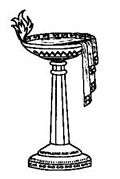Sudhir Khastgir
| Sudhir Ranjan Khastgir | |
|---|---|
 | |
| Born |
24 September 1907 Chittagong, Bangladesh |
| Died |
6 June 1974 (aged 66) Kolkata, West Bengal, India |
| Nationality | Indian |
| Known for | Painting |
| Movement | Bengal school of art, Modern Indian Art |
Sudhir Ranjan Khastgir (24 September 1907 – 6 June 1974) was an Indian painter of Bengal school of art and an art educator.[1] A pupil of Abanindranath Tagore and Nandalal Bose, Sudhir was known for "Indian style" of painting. He graduated from Visva-Bharati University at Santiniketan in 1929. He was influenced by the Tagore family and his classic works include paintings of scenes from Indian mythologies, women, and village life.[2] He was also the first Art teacher at The Doon School, Dehradun, when it opened in 1935. Today, the many statues and murals on display at Doon, and frescoes of dancers at the entrance of a local cinema hall, 'The Orient', are a product of his creation.[3][4]
Life and career
Sudhir was born in Chittagong, Bangladesh in 1907.[5] He soon moved to Kolkata, India for his schooling. After graduating from the Visva-Bharati University at Santiniketan, he went to Academy of Fine Arts, Munich to study Fine Arts on a scholarship. After returning from Munich, he became the first Arts master at the newly opened The Doon School. He remained in Doon for the next 20 years.[6][7] During this period, he also directed some dance-dramas based on the works of Rabindranath Tagore.[5]
While at Doon, he achieved considerable national fame and was invited by the Uttar Pradesh Government to head Lucknow College of Arts and Crafts, Lucknow (University of Lucknow) in 1956.[8]
He was awarded the Padma Shri award by Government of India in 1957, for his significant contributions to Indian art.[9][10]
Family
His elder brother, Satish Ranjan Khastgir, was a noted physicist, whose granddaughter is married to writer Amit Chaudhuri, while his own daughter Shyamoli Khastgir, an environmental activist, once married to architect, Lee Tan, lives in Purba Palli, Shantiniketan.[5]
References
- Notes
- ↑ "Bengal artists at home in Chennai gallery". The Times Of India. Times News Network. 2012-03-20. Retrieved 2012-05-16.
- ↑ "Sudhir R. Khastgir". EPaintings. Retrieved 2012-05-16.
- ↑ "Bonfire Of Vanities | Vishvjit P. Singh". Outlook (magazine). Retrieved 2012-05-16.
- ↑ "The Hub". Tehelka. Retrieved 2012-05-16.
- 1 2 3 Amit Chaudhuri. "Editorial: Secrets And Treasures". The Telegraph (Kolkata). Retrieved 2012-05-16.
- ↑ "Artist Gellary - SUDHIR KHASTGIR". Goaartgallery.com. Retrieved 2012-05-16.
- ↑ Constructing Post-Colonial India: National Character and the Doon School - Sanjay Srivastava - Google Books. Books.google.co.in. Retrieved 2012-05-16.
- ↑ Fine art Lucknow University
- ↑ "Faculty of Fine Arts". Lucknow University. Retrieved 2012-05-16.
- ↑ "Padma Awards Directory (1954-2009)" (PDF). Ministry of Home Affairs.
- Bibliography
- Sudhir Ranjan Khastgir by S.R. Khastgir, Gallerie 88, 2008
- Myself by Sudhir Khastgir, 1955
- Sudhir Ranjan by Khastgir, Lalit Kala Academi 1978.
